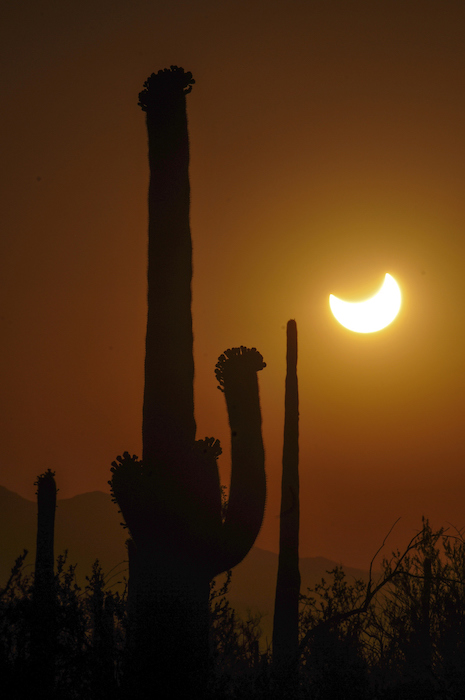World View is developing a balloon-based system that will take passengers up to an altitude of 100,000 feet (30,000 meters) or so in a pressurized capsule, allowing them to see the curvature of the Earth and the blackness of space. The ride will be gentle and relatively lengthy, lasting 5 to 6 hours from liftoff to touchdown. Tickets aboard the six-passenger capsule (which accommodates two crew) currently sell for $75,000 apiece, and the first commercial crewed flights were scheduled to begin in 2017…
Tucson’s Pima County’s Board of Supervisors voted 4-1 in favor of setting up Spaceport Tucson, which the county will own but World View will operate. The vote authorized a bond sale of $15 million to build all of these facilities.
World View will construct a headquarters building next to the spaceport, to serve as a tenant of the new Pima County Aerospace, Defense and Technology Business & Research Park.
Editors Note: Tucson’s biggest shot in the arm to grow and flourish came with World War II, the world needed pilots and flyers and Tucson had air fields, Davis Montana AFB and flying weather. After the war folks who came here to train came back and brought everyone with them….Tucson grew by 100,000 people in one decade. The point to be made, Tucson’s airfields had what the Air Force needed, when it was needed. World View has critics, particularly tax payers who wonder why they should pay for World’s View playground.
Hopefully like airfields, space ports will become needed for new access to Space and Tucson will become the Gateway to the Stars…
Tucson Moon Tree on the University of Arizona’s Campus, the seed went to the Moon and was planted here.
VECTOR ROCKETS BUILT IN TUCSON
Vector Rockets wants to provide launch services with two rockets, the smaller Vector-R, and the larger Vector-H. Both rockets use a single engine for their second stage and a cluster of engines (three in the Vector-R and six in the Vector-H) for their first stage, all of which use liquid oxygen and propylene as propellants.
The 45-foot-tall, two-stage Vector-R is designed to carry payloads up to about 140 lbs to low-Earth orbit at a cost of $1.5 million. Less than half Rocket Lab’s larger Electron rocket cost, whose debut test flight was held in New Zealand.

Lunar Eclipse seen at sunset within Saguaro National Monument West
An optional third-stage electric motor on a Vector-R can deliver a satellite up to 500 miles above Earth for an additional $500,000. The larger Vector-H version sells for about $3 million. The rockets are simple, with no pumps, and fewer components than the competition. The Vector’s first stage, for example, has just 15 parts. Launches are presently held on the East coast in Florida. One launch was planned from Kodiak Island in Alaska.
The original idea behind Vector was to build a satellite-based system that would allow customers to use software to operate sensors, using a constellation of satellites as “virtual machines.” Galactic Sky, as that concept is being developed as Vector perfects its launch business, a billion-dollar business by itself. Vector plans a 70,000-square-foot rocket factory in Tucson after securing a lease with Pima County for the county’s Aerospace, Defense and Technology Business & Research Park. The company, which has about 25 employees now, plans to add 40 to 80 people, mainly engineers and skilled workers like machinists, early and hopes to hire 200 employees in Tucson in a few years. Besides Tucson, the company has operations in Orange County and San Jose, California. The lease deal came after a successful test of the new rocket engine Vector is developing with NASA. Vector already has more than 100 launch contracts in hand.






































 aeronautical engineer, test pilot and NASA astronaut, best remembered as the Commander of Apollo 8, the first mission to fly around the Moon making him, along with crew mates Jim Lovell and Bill Anders, the first of only 24 humans to do so before flying on Apollo, Norman set a fourteen-day spaceflight endurance record on Gemini 7, and also served on the NASA review board which investigated the Apollo One fire. After leaving NASA, he was the CEO of Eastern Airlines from 1975 to 1986.
aeronautical engineer, test pilot and NASA astronaut, best remembered as the Commander of Apollo 8, the first mission to fly around the Moon making him, along with crew mates Jim Lovell and Bill Anders, the first of only 24 humans to do so before flying on Apollo, Norman set a fourteen-day spaceflight endurance record on Gemini 7, and also served on the NASA review board which investigated the Apollo One fire. After leaving NASA, he was the CEO of Eastern Airlines from 1975 to 1986.



















Leave a comment